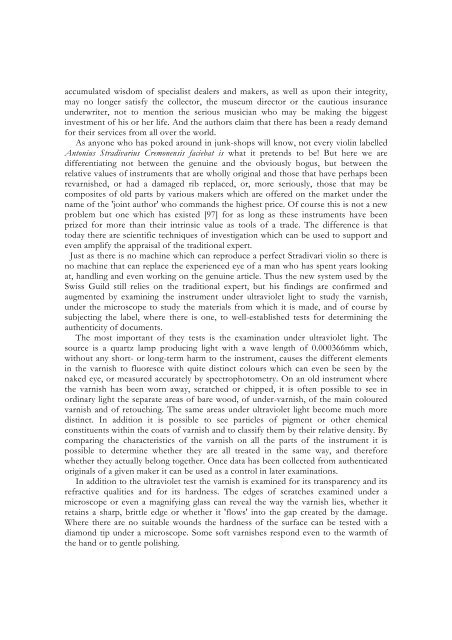Create successful ePaper yourself
Turn your PDF publications into a flip-book with our unique Google optimized e-Paper software.
accumulated wisdom of specialist dealers and makers, as well as upon their integrity,may no longer satisfy the collector, the museum director or the cautious insuranceunderwriter, not to mention the serious musician who may be making the biggestinvestment of his or her life. And the authors claim that there has been a ready demandfor their services from all over the world.As anyone who has poked around in junk-shops will know, not every violin labelledAntonius Stradivarius Cremonensis faciebat is what it pretends to be! But here we aredifferentiating not between the genuine and the obviously bogus, but between therelative values of instruments that are wholly original and those that have perhaps beenrevarnished, or had a <strong>da</strong>maged rib replaced, or, more seriously, those that may becomposites of old parts by various makers which are offered on the market under thename of the 'joint author' who commands the highest price. Of course this is not a newproblem but one which has existed [97] for as long as these instruments have beenprized for more than their intrinsic value as tools of a trade. The difference is thatto<strong>da</strong>y there are scientific techniques of investigation which can be used to support andeven amplify the appraisal of the traditional expert.Just as there is no machine which can reproduce a perfect Stradivari violin so there isno machine that can replace the experienced eye of a man who has spent years lookingat, handling and even working on the genuine article. Thus the new system used by theSwiss Guild still relies on the traditional expert, but his findings are confirmed an<strong>da</strong>ugmented by examining the instrument under ultraviolet light to study the varnish,under the microscope to study the materials from which it is made, and of course bysubjecting the label, where there is one, to well-established tests for determining theauthenticity of documents.The most important of they tests is the examination under ultraviolet light. Thesource is a quartz lamp producing light with a wave length of 0.000366mm which,without any short- or long-term harm to the instrument, causes the different elementsin the varnish to fluoresce with quite distinct colours which can even be seen by thenaked eye, or measured accurately by spectrophotometry. On an old instrument wherethe varnish has been worn away, scratched or chipped, it is often possible to see inordinary light the separate areas of bare wood, of under-varnish, of the main colouredvarnish and of retouching. The same areas under ultraviolet light become much moredistinct. In addition it is possible to see particles of pigment or other chemicalconstituents within the coats of varnish and to classify them by their relative density. Bycomparing the characteristics of the varnish on all the parts of the instrument it ispossible to determine whether they are all treated in the same way, and thereforewhether they actually belong together. Once <strong>da</strong>ta has been collected from authenticatedoriginals of a given maker it can be used as a control in later examinations.In addition to the ultraviolet test the varnish is examined for its transparency and itsrefractive qualities and for its hardness. The edges of scratches examined under amicroscope or even a magnifying glass can reveal the way the varnish lies, whether itretains a sharp, brittle edge or whether it 'flows' into the gap created by the <strong>da</strong>mage.Where there are no suitable wounds the hardness of the surface can be tested with adiamond tip under a microscope. Some soft varnishes respond even to the warmth ofthe hand or to gentle polishing.
















